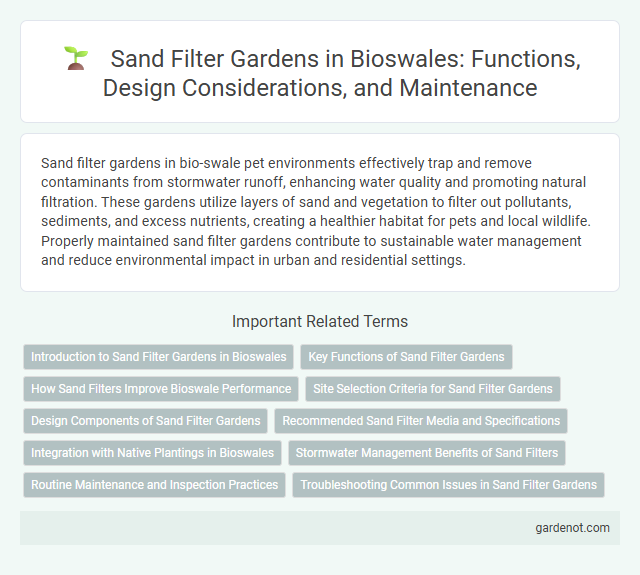Sand filter gardens in bio-swale pet environments effectively trap and remove contaminants from stormwater runoff, enhancing water quality and promoting natural filtration. These gardens utilize layers of sand and vegetation to filter out pollutants, sediments, and excess nutrients, creating a healthier habitat for pets and local wildlife. Properly maintained sand filter gardens contribute to sustainable water management and reduce environmental impact in urban and residential settings.
Introduction to Sand Filter Gardens in Bioswales
Sand filter gardens in bioswales utilize layered sand media to enhance stormwater filtration by trapping sediments, nutrients, and pollutants. These gardens promote infiltration while supporting vegetation that aids in pollutant uptake and soil stabilization. Effective sand filter design optimizes hydraulic conductivity and pollutant removal efficiency, contributing to improved urban water quality management.
Key Functions of Sand Filter Gardens
Sand filter gardens effectively remove pollutants from stormwater through physical filtration and microbial processes. These gardens trap sediments, nutrients, and pathogens while enhancing water infiltration to reduce runoff volume. Their key functions include improving water quality, promoting groundwater recharge, and supporting urban ecosystem health.
How Sand Filters Improve Bioswale Performance
Sand filters enhance bioswale performance by increasing water infiltration and removing pollutants such as sediments, nutrients, and heavy metals from stormwater runoff. The porous nature of sand media supports microbial activity that breaks down contaminants, improving water quality before it enters natural waterways. Integration of sand filters also reduces flooding risk by slowing runoff and promoting groundwater recharge.
Site Selection Criteria for Sand Filter Gardens
Optimal site selection for sand filter gardens requires well-drained soils with moderate permeability to ensure efficient water infiltration and pollutant removal. Proximity to pollutant sources such as parking lots or rooftops enhances effectiveness by targeting runoff at its origin. Areas with gentle slopes between 1% and 5% facilitate proper filtration while preventing erosion and sediment buildup in the bio-swale system.
Design Components of Sand Filter Gardens
Sand filter gardens incorporate multiple design components, including a layered sand bed for effective filtration, native vegetation to enhance pollutant uptake, and an underdrain system to facilitate efficient water flow. The sand bed layer is crucial for trapping sediments and reducing nutrient loads before water percolates into the soil. Integrating permeable boundaries and overflow structures ensures optimal water retention time and prevents clogging, maximizing the bio-swale's performance in stormwater management.
Recommended Sand Filter Media and Specifications
Recommended sand filter media for bio-swale sand filter gardens include uniform silica sand with a particle size ranging from 0.3 to 0.5 mm to ensure optimal filtration and water flow. Specifications emphasize a minimum depth of 300 mm for the sand layer, supported by a well-graded gravel base to enhance drainage and prevent clogging. Proper media selection and layering guarantee effective pollutant removal and prolonged system performance in stormwater management.
Integration with Native Plantings in Bioswales
Sand filter gardens enhance bioswales by promoting natural filtration through layers of sand and soil, effectively capturing pollutants and sediments. Integrating native plantings within these gardens supports local biodiversity, improves soil stability, and increases water infiltration rates. Native vegetation's deep root systems complement sand filtration by maintaining permeability and preventing erosion, resulting in more efficient stormwater management.
Stormwater Management Benefits of Sand Filters
Sand filter gardens effectively improve stormwater quality by trapping sediments, nutrients, and pollutants, reducing runoff contamination. Their permeability enhances groundwater recharge while preventing localized flooding through controlled infiltration rates. By promoting natural filtration processes, sand filters contribute to sustainable urban stormwater management and mitigate the impact on aquatic ecosystems.
Routine Maintenance and Inspection Practices
Routine maintenance and inspection of sand filter gardens include regular removal of sediment buildup and debris to maintain optimal filtration efficiency. Checking the sand layer depth and replacing or replenishing sand as needed prevents clogging and ensures effective water percolation. Monitoring inlet and outlet structures for blockages or damage supports continuous performance in bio-swale stormwater management systems.
Troubleshooting Common Issues in Sand Filter Gardens
Sand filter gardens often face clogging issues caused by excessive sediment and organic matter accumulation, which reduces infiltration rates and water flow. Regular maintenance, such as removing debris and aerating the sand layer, helps restore permeability and prevents stagnation. Monitoring pH levels and ensuring proper vegetation coverage also mitigates nutrient imbalances and promotes effective filtration in bio-swale systems.
Sand filter garden Infographic

 gardenot.com
gardenot.com